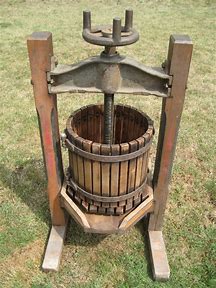I have been gifted/given an extended loan of an EJWOX 1.6 gallon fruit press.
This thing: https://ejwox.com/collections/frontpage/products/1-6-gallon-classic-wooden-wine-cider-fruit-press
Unfortunately they do not have instructions on their website for it. I am going to assemble it with a friend tomorrow.
Has anyone used this press or a similar press? Anything I should look out for? Tips, tricks, problems?
I was told people sometimes modify it slightly with "spacers".
I looked at their "filter bags" and they look a lot like paint strainer bags. I'll compare the thickness of the one that came with it to paint strainer bags. If they are basically identical I'll just use paint strainers. I was also thinking of seeing if I could sew together some muslin to create a bag/press cloth.
It does not come with the crusher/grinder and I don't have nor will I probably be getting an apple scratter.
I was thinking of getting around this by simply chopping the apples into medium size chunks prior to pressing. Or freezing the apple pieces and then thawing them out to soften them. I doubt I'll be doing a ton at once until next summer and fall so I'm not too worried it taking longer to freeze and thaw before pressing.
I'm not convinced I will get a better yield off of this thing than I would with my technique of pureeing apples and squeezing the pulp through muslin. Juice yield seems to be mostly dependent on the texture. Crisper, harder fleshed apples (Granny Smith) juice really easily. I can wring almost all the liquid out of them. Softer, mealier textured apples (McIntosh) yield a lot less juice.
This thing: https://ejwox.com/collections/frontpage/products/1-6-gallon-classic-wooden-wine-cider-fruit-press
Unfortunately they do not have instructions on their website for it. I am going to assemble it with a friend tomorrow.
Has anyone used this press or a similar press? Anything I should look out for? Tips, tricks, problems?
I was told people sometimes modify it slightly with "spacers".
I looked at their "filter bags" and they look a lot like paint strainer bags. I'll compare the thickness of the one that came with it to paint strainer bags. If they are basically identical I'll just use paint strainers. I was also thinking of seeing if I could sew together some muslin to create a bag/press cloth.
It does not come with the crusher/grinder and I don't have nor will I probably be getting an apple scratter.
I was thinking of getting around this by simply chopping the apples into medium size chunks prior to pressing. Or freezing the apple pieces and then thawing them out to soften them. I doubt I'll be doing a ton at once until next summer and fall so I'm not too worried it taking longer to freeze and thaw before pressing.
I'm not convinced I will get a better yield off of this thing than I would with my technique of pureeing apples and squeezing the pulp through muslin. Juice yield seems to be mostly dependent on the texture. Crisper, harder fleshed apples (Granny Smith) juice really easily. I can wring almost all the liquid out of them. Softer, mealier textured apples (McIntosh) yield a lot less juice.


